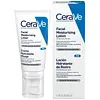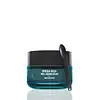What's inside
What's inside
 Key Ingredients
Key Ingredients

 Benefits
Benefits

 Concerns
Concerns

 Ingredients Side-by-side
Ingredients Side-by-side

Water
Skin ConditioningGlycerin
HumectantCaprylic/Capric Triglyceride
MaskingNiacinamide
SmoothingCetearyl Alcohol
EmollientPotassium Phosphate
BufferingCeramide NP
Skin ConditioningCeramide AP
Skin ConditioningCeramide EOP
Skin ConditioningCarbomer
Emulsion StabilisingDimethicone
EmollientCeteareth-20
CleansingBehentrimonium Methosulfate
Sodium Lauroyl Lactylate
EmulsifyingSodium Hyaluronate
HumectantCholesterol
EmollientPhenoxyethanol
PreservativeDisodium EDTA
Dipotassium Phosphate
BufferingCaprylyl Glycol
EmollientPhytosphingosine
Skin ConditioningXanthan Gum
EmulsifyingPolyglyceryl-3 Diisostearate
EmulsifyingEthylhexylglycerin
Skin ConditioningWater, Glycerin, Caprylic/Capric Triglyceride, Niacinamide, Cetearyl Alcohol, Potassium Phosphate, Ceramide NP, Ceramide AP, Ceramide EOP, Carbomer, Dimethicone, Ceteareth-20, Behentrimonium Methosulfate, Sodium Lauroyl Lactylate, Sodium Hyaluronate, Cholesterol, Phenoxyethanol, Disodium EDTA, Dipotassium Phosphate, Caprylyl Glycol, Phytosphingosine, Xanthan Gum, Polyglyceryl-3 Diisostearate, Ethylhexylglycerin
Aloe Barbadensis Leaf Juice Powder
Skin ConditioningWater
Skin ConditioningPolyglyceryl-3 Cetyl Ether
EmulsifyingCaprylic/Capric Triglyceride
MaskingGlyceryl Stearate
EmollientGlycerin
HumectantPropanediol
SolventCoco-Caprylate/Caprate
EmollientRosa Canina Fruit Oil
EmollientC13-15 Alkane
SolventCetyl Alcohol
EmollientSimmondsia Chinensis Seed Oil
EmollientIsoamyl Laurate
EmollientPrunus Amygdalus Dulcis Oil
Skin ConditioningSesamum Indicum Seed Oil
EmollientCapparis Spinosa Bud Extract
Skin ConditioningMorus Nigra Leaf Extract
Skin ConditioningRhodiola Rosea Root Extract
EmollientCaesalpinia Spinosa Fruit Extract
Skin ProtectingGlycogen
HumectantDimer Dilinoleyl Dimer Dilinoleate
EmollientHyaluronic Acid
HumectantHydrolyzed Rhodophyceae Extract
Hectorite
AbsorbentParfum
MaskingBenzyl Alcohol
PerfumingArginine
MaskingLevulinic Acid
PerfumingSodium Gluconate
Skin ConditioningSuccinoglycan
Skin ConditioningMalic Acid
BufferingSodium Levulinate
Skin ConditioningIsoamyl Cocoate
Xanthan Gum
EmulsifyingP-Anisic Acid
MaskingDehydroacetic Acid
PreservativeGlycine Soja Oil
EmollientTocopherol
AntioxidantBeta-Sitosterol
Emulsion StabilisingSqualene
EmollientMaris Sal
Skin ConditioningAloe Barbadensis Leaf Juice Powder, Water, Polyglyceryl-3 Cetyl Ether, Caprylic/Capric Triglyceride, Glyceryl Stearate, Glycerin, Propanediol, Coco-Caprylate/Caprate, Rosa Canina Fruit Oil, C13-15 Alkane, Cetyl Alcohol, Simmondsia Chinensis Seed Oil, Isoamyl Laurate, Prunus Amygdalus Dulcis Oil, Sesamum Indicum Seed Oil, Capparis Spinosa Bud Extract, Morus Nigra Leaf Extract, Rhodiola Rosea Root Extract, Caesalpinia Spinosa Fruit Extract, Glycogen, Dimer Dilinoleyl Dimer Dilinoleate, Hyaluronic Acid, Hydrolyzed Rhodophyceae Extract, Hectorite, Parfum, Benzyl Alcohol, Arginine, Levulinic Acid, Sodium Gluconate, Succinoglycan, Malic Acid, Sodium Levulinate, Isoamyl Cocoate, Xanthan Gum, P-Anisic Acid, Dehydroacetic Acid, Glycine Soja Oil, Tocopherol, Beta-Sitosterol, Squalene, Maris Sal
 Reviews
Reviews

Ingredients Explained
These ingredients are found in both products.
Ingredients higher up in an ingredient list are typically present in a larger amount.
This ingredient is an emollient, solvent, and texture enhancer. It is considered a skin-softener by helping the skin prevent moisture loss.
It helps thicken a product's formula and makes it easier to spread by dissolving clumping compounds.
Caprylic Triglyceride is made by combining glycerin with coconut oil, forming a clear liquid.
While there is an assumption Caprylic Triglyceride can clog pores due to it being derived from coconut oil, there is no research supporting this.
Learn more about Caprylic/Capric TriglycerideGlycerin is already naturally found in your skin. It helps moisturize and protect your skin.
A study from 2016 found glycerin to be more effective as a humectant than AHAs and hyaluronic acid.
As a humectant, it helps the skin stay hydrated by pulling moisture to your skin. The low molecular weight of glycerin allows it to pull moisture into the deeper layers of your skin.
Hydrated skin improves your skin barrier; Your skin barrier helps protect against irritants and bacteria.
Glycerin has also been found to have antimicrobial and antiviral properties. Due to these properties, glycerin is often used in wound and burn treatments.
In cosmetics, glycerin is usually derived from plants such as soybean or palm. However, it can also be sourced from animals, such as tallow or animal fat.
This ingredient is organic, colorless, odorless, and non-toxic.
Glycerin is the name for this ingredient in American English. British English uses Glycerol/Glycerine.
Learn more about GlycerinWater. It's the most common cosmetic ingredient of all. You'll usually see it at the top of ingredient lists, meaning that it makes up the largest part of the product.
So why is it so popular? Water most often acts as a solvent - this means that it helps dissolve other ingredients into the formulation.
You'll also recognize water as that liquid we all need to stay alive. If you see this, drink a glass of water. Stay hydrated!
Learn more about WaterXanthan gum is used as a stabilizer and thickener within cosmetic products. It helps give products a sticky, thick feeling - preventing them from being too runny.
On the technical side of things, xanthan gum is a polysaccharide - a combination consisting of multiple sugar molecules bonded together.
Xanthan gum is a pretty common and great ingredient. It is a natural, non-toxic, non-irritating ingredient that is also commonly used in food products.
Learn more about Xanthan Gum